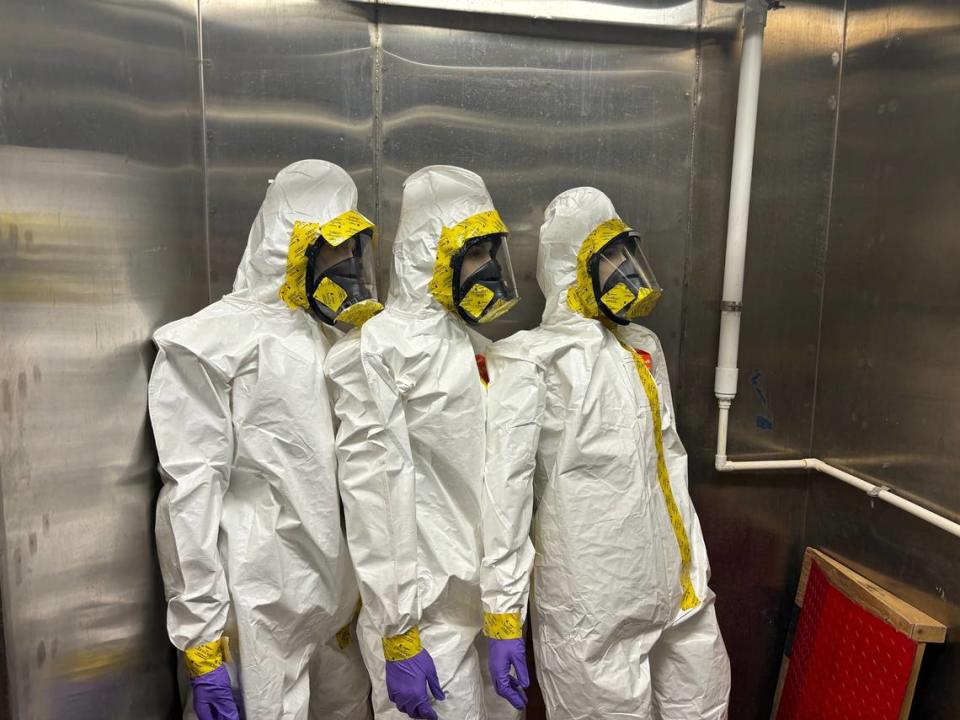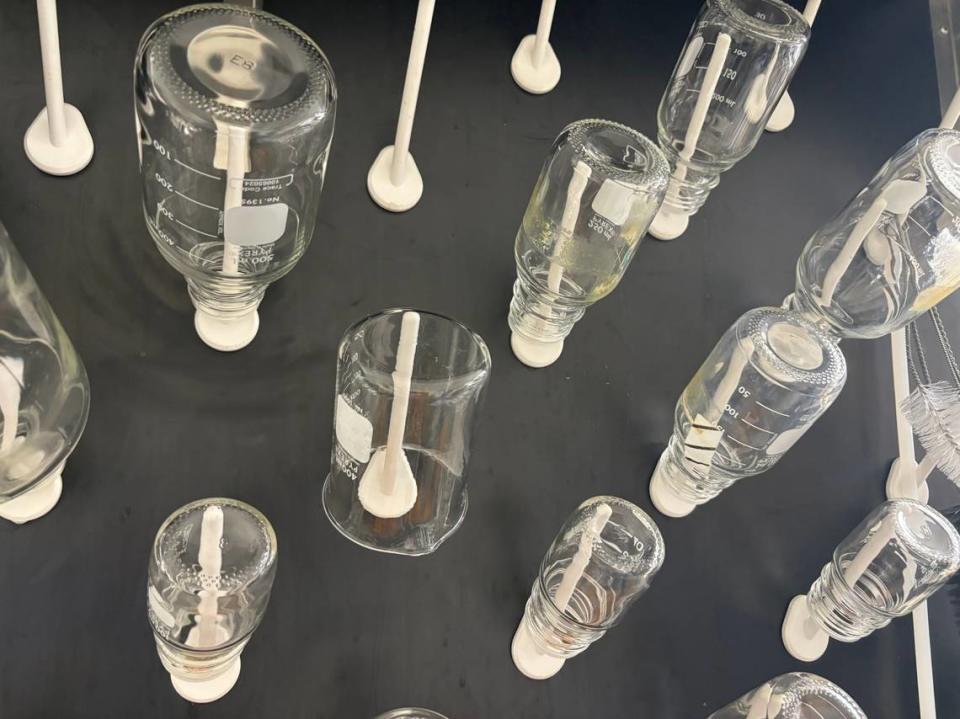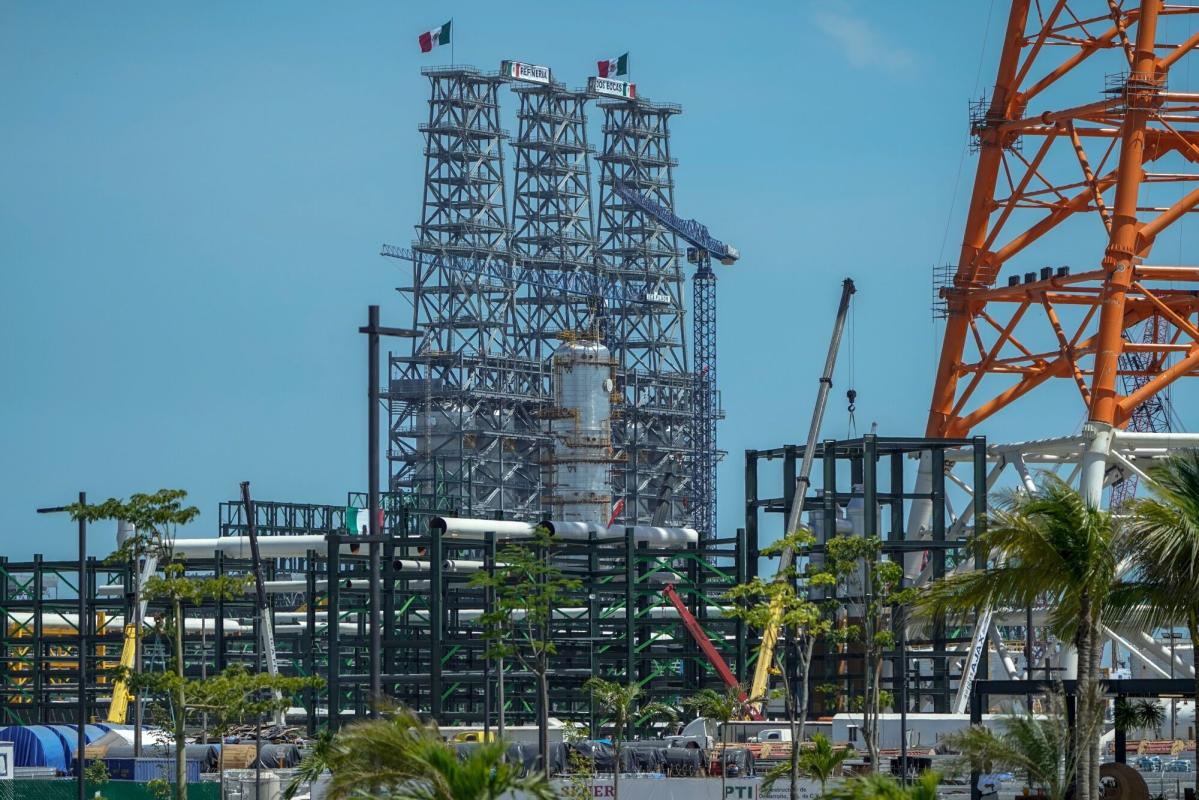How should officials respond to an anthrax attack on a subway train? Which woods emit more toxins when they burn (hint: eucalyptus and peat) and which less (red oak and pine)?
Are there non-animal alternatives to testing lab mice? And how do researchers forensically trace per- and polyfluoroalkyl substances — better known as PFASs — to corporate polluters?
The answers are tucked within 509 acres along the western edge of Research Triangle Park, where the U.S. Environmental Protection Agency operates its biggest physical campus.
There, a warren of offices and labs represent the backbone of the country’s air quality research and regulations. More than 2,000 full-time federal employees and contractors report to the site, combining to identify contaminants — both known and novel — test permissible levels, assess research and recommend air quality standards.
The campus is vast and verdant, with trees enveloping a cluster of main buildings backed by a lake. Underground hallways link the core structures, enabling workers to move seamlessly across departments.
A significant portion of the EPA’s total energy output is produced at the massive site, and the federal agency, striving to practice what it preaches, uses roof-top solar panels, toxin-filtering plants and window bird films to reduce its own environmental impact. A vivarium houses test mice while the agency advances what it calls new approach methods that don’t rely on animals.
Born from a political promise
Even before the agency formed, the EPA was destined for the Triangle in North Carolina. In 1960, North Carolina Gov. Terry Sanford agreed to support then-Massachusetts Sen. John F. Kennedy for president in exchange for the federal government establishing an environmental research facility in the fledgling Research Triangle Park.
After Kennedy’s assassination, Sanford approached new President Lyndon B. Johnson to assure he would fulfill his predecessor’s verbal commitment. He did.
In 1967, the Public Health Service and National Center for Air Pollution Control moved a few dozen staff members to Durham, and the next year, the nonprofit Research Triangle Foundation sold 509 acres to the federal government for a dollar. The land was to be shared between the NCAPC (later the EPA) and the National Institute of Environmental Health Sciences.
Despite forming in 1970, the EPA didn’t build on the campus for a few decades. Instead, the agency divided its growing local workforce between multiple Triangle sites, including the N.C. Mutual Life Insurance Building in downtown Durham and a 295,000-square-foot structure in Research Triangle Park nicknamed “The Fortress” for its stern aesthetic exterior.
Only in the 1990s did the federal government allocate $272 million to construct its current campus, which opened in 2001.
Finding forever chemicals
Since then, the EPA has been one of the largest and steadiest residents of the Park, shielded from mercurial business cycles and, at least in its labs, the post-pandemic shift toward remote work that has left parts of RTP feeling emptier.
“Having a federal lab, it’s pretty unique for a research park, said Scott Levitan, CEO of the Research Triangle Foundation.
Following the Sept. 11, 2001, terrorist attacks and ensuing series of anthrax mail incidents, the government created the EPA Homeland Security Research Program. At its RTP labs, this division uses a benign surrogate to study how anthrax spreads and how best to clear it quickly from enclosed areas. One room contains a 3,000-cubic-foot test section that isn’t dissimilar from a passenger train car.
“This particular monstrosity behind us is the aerosol wind tunnel,” John Archer, a research industrial hygienist, said during a tour last month. “It is one of the largest wind tunnels, especially for human exposure research, looking at aerosol flow and transport and measurement in the U.S., as well as potentially the world.”

Another topic of study at the campus is man-made PFAS, nicknamed “forever chemicals” for their long-lasting compounds that have been connected to adverse human health effects. In 2017, high concentrations of PFAS were discovered to be coming from the facility of the chemical manufacturer Chemours south of Fayetteville and flowing into the Cape Fear River.
EPA chemist Mark Strynar detailed how his lab works backward to confirm PFAS sources by determining a chemical’s precise molecular weight to predict its formula, then proposing a structure, before sifting through patent documents to find which companies may have produced such a compound. The process involves multiple steps and a boxy instrument called a high-resolution mass spectrometer.
“We look for chemicals that aren’t on the hit list of everybody else,” Strynar said. “My job is to find chemicals, point it out, find out where it is. That takes sleuthing.”

Signup bonus from




